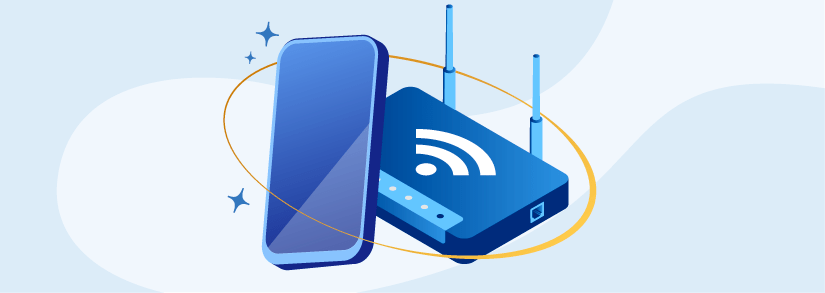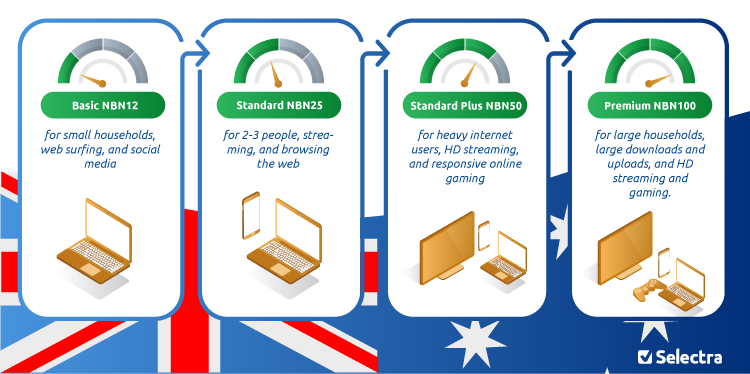Mobile and Broadband Technology in Australia

The technology that keeps us connected has long since evolved from the days of old. Today, broadband and mobile technologies allow us to do more with our computers or smartphone than ever before. With acronyms such as NBN, ADSL, 4G, 5G, and VoIP thrown about, it can be difficult to understand what it all means. Discover the types of broadband connections in Australia, the difference between 4G and 5G, and more, by reading below.
NBN and fibre network
Fibre optic networks are a type of internet connection that utilizes fibre optic cables to bring high-speed internet to users. The National Broadband Network in Australia is the government initiative to expand the reach of high-speed internet across the country, using not only fibre-optic cables, but also satellite broadband, and wireless broadband, to reach as many Australians as possible.
What is the NBN
The National Broadband Network (NBN) is the government-implemented, high-speed broadband service currently rolling out across Australia. The NBN is a mix of different fibre-optic, wireless and satellite technologies aimed to bring the internet into as many Australian homes as possible.
The NBN first started as an initiative by the Australian Labor Party in 2007, which said that if elected they would begin to build the infrastructure to create a high-speed national broadband network. In 2009, NBN Co was established with the task to create, build, and then operate the network as a wholesaler of broadband services.
Since then, the NBN has been implemented across Australia and covers almost all of the population by 2025. Today, the NBN covers a large majority of the Australian population, with 91% of homes and businesses able to connect to the network.
NBN speeds: What’s best for me?
NBN services are divided into different speed tiers. While the actual broadband speed you may experience, and what is available to you, might differ based on the type of NBN connection you have and how many others are using the same service, these speed tiers are considered the maximum speed you could get from your broadband service.
- Basic or NBN12 - 12Mbps download speed, 1Mbps upload speed. Ideal for small households and light internet users.
- Standard or NBN25 - 25Mbps download speed, 5Mbps upload speed. Best for 2-3 people households who occasionally stream television and browse social media.
- Standard Plus or NBN50 - 50Mbps download speed, 20Mbps upload speed. Good for heavier internet users who want HD streaming and occasionally game online.
- Premium or NBN100 - 100Mbps download speed, 40Mbps upload speed. Perfect for larger households or frequent internet users, or for HD streaming and gaming.

A few ISPs offer speeds faster than NBN100, including Aussie Broadband which offers maximum speeds up to 250Mbps or even NBN 1000. Most internet users, however, will have no issue with NBN25 or NBN50 for typical use.
Check your speedsWant to see if your internet is working optimally? Selectra's internet speed test will let you know how fast your broadband is!
Types of NBN Connections
The NBN is comprised of different types of broadband technologies in a bid to get high-speed internet access to as much of the population as possible. While it mostly relies on fibre optic cables, it also uses wireless technologies to reach more regional customers.
The broadband technologies implemented by the NBN include:
- Fibre to the Premises (FTTP) - The fibre optic cable runs directly into your house
- Fibre to the Building (FTTB) - The fibre optic cable is installed into a building or apartment complex, where it is then extended to reach all offices or apartments
- Fibre to the Node (FTTN) - The fibre optic cable is installed outside of the home, then connected to multiple premises
- Hybrid-Fibre Coaxial (HFC or Pay TV Cable) - High-speed broadband is installed into the home using the existing cable or pay-TV network
- Fixed Wireless - An antenna and fixed modem are installed into the house, which then connects to a radio base station
- Satellite NBN - Satellites and satellite dishes connect to bring broadband into rural or regional houses
Most people within the NBN range will only need to worry about the first three types of connections, as they are most common. However, every home is different and where you live will determine the type of broadband connection available to you.
Is NBN available to me?
The NBN has been extending across Australia since its first services went live in 2011. Now, over 10 million homes and businesses are eligible to connect to the NBN, with 6.4 million actually connected.
You can also see whether or not you’re within the NBN on the NBN Co. website as well as see places where the expansion of the NBN has begun.

Compare Plans, Sign Up & Start Saving Today!
See the Latest Offers and Switch Today, Hassle-Free
Wireless and mobile broadband
Wireless and mobile broadband are popular options for those where NBN has not yet arrived.
Unlike traditional broadband methods, both alternatives are powered by the 5G mobile network. While wireless broadband and mobile broadband both connect to the same type of network, there are some major differences between the two.
What is wireless home broadband?
Wireless broadband is intended for home use, requiring a constant power source into a special wireless broadband modem. Unlike NBN or ADSL, wireless broadband doesn’t require a special technician to come out and install the technology into your residence but rather you can just plug it in and go, making it an attractive choice for people who frequently move homes or rent.
Wireless broadband plans tend to have capped data options (generally between 200GB and 500GB per month), unlike the increasingly popular unlimited data available with more traditional broadband technologies. Speeds vary with wireless broadband, with lower-priced options capping their download speeds at 12Mbps (comparable to entry-level Standard NBN) while other wireless broadband providers offer network speeds of up to, and even more than, 20Mbps.
Mobile broadband: data-only for on-the-go
Mobile broadband, like wireless home broadband, connects to the internet using the mobile phone network. Unlike wireless home broadband, mobile broadband is mobile. Customers can insert the mobile broadband SIM-card into any data-enabled device such as a tablet, WIFI dongle, or battery-powered hot-spot. Oftentimes, mobile broadband plans are also called data-only plans, as these operate in the same way a mobile phone plan does, but come without services such as talk or SMS allowances.
Mobile broadband plans range from 1GB of data per month up to 250GB, and run at the same speeds as other data-enabled devices.
Rural and regional broadband options
While the NBN continues to expand in the urban areas of Australia, those living in rural or regional places across the country face unique difficulties when it comes to fast and reliable internet access.
Rural mobile or wireless broadband
If NBN is not a reliable option, mobile or wireless home broadband on the 4G or 5G network is a worthy contender. While all three mobile network providers in Australia cover a great majority of the population, Telstra’s 98% population coverage boasts the biggest percentage, particularly in rural regions.
The drawback to mobile broadband is that structures such as large buildings or mountains can interrupt your connection, and coverage might not be perfect in your entire house.
Satellite broadband for rural and regional residents
While more expensive, satellite broadband is an option for those where NBN or mobile broadband is not available. However, with the government’s National Broadband Guarantee, many are eligible for assistance with installation costs for a satellite connection.
While a good option for those living too far from an NBN connection, or where a mobile network doesn’t reach, satellite broadband is still affected by issues such as cloud cover or weather conditions.

Looking for Broadband & Mobile Deals?
See exclusive online offers from Southern Phone! Compare NBN plans and providers.
Mobile phone technology
In just a short span of time, mobile phones have become an invaluable part of everyday life. From keeping up with the latest TV shows, to checking in on friends, to working away from the office, mobile phones bring the world together in ways that were never possible just a few short years ago. Mobile phones are always evolving, as well, with technology evolving in ways humankind couldn’t have imagined in the last century.
5G and the future
As mentioned previously, 5G has rolled out across the country through Telstra and Optus. 5G, or 5th generation cellular wireless technology uses a system of cell sites (like previous cellular wireless technology) to send data over radio waves. Unlike 4G, and other generations, 5G utilizes higher, short-distance millimeter-wave frequencies to increase flexibility and speeds while lowering latency to allow for a more receptive experience.
But, just how fast is 5G compared to 4G?5G is expected to reach download speeds of more than 10Gigabits/second, compared to 4G’s 10Megabits/second. This is due to 5G technology using larger channels than 4G, made possible on those higher radio frequencies that 4G doesn’t reach, as well as more efficient encoding.
Outside of mobile phones, 5G can be applied to areas such as:
- Medicine to allow for virtual diagnosing and virtual surgeries
- Fully autonomous vehicles
- Better online banking and banking security
By increasing the connectedness of all mobile network devices, they will be able to work together with more speed and efficiency than ever before.
Satellite phones
While the three network providers in Australia cover up to 98% of the population, this does not mean full network coverage across the country. Indeed, for those living in isolated or rural areas, it’s not only difficult to connect to a mobile network, but it can also be dangerous. For those who cannot connect to the mobile network, satellite phones, or sat phones, are an important and necessary tool to keep connected.
Sat phones work differently from traditional mobile phones. While mobile phones connect to nearby radio towers on Earth, sat phones (as their name suggest) connect to satellites orbiting around the Earth in space. This means that even if you don’t get mobile network coverage, you can still be connected via satellite to anywhere in the world. While they are paramount for those who live in isolated areas, the lack of demand and minimal satellite infrastructure means these phones can be costly.
In addition, the distance between the caller, the satellite, and the recipient, means that there is a delay in the conversation.
Broadband and Mobile Technology FAQ
What is the NBN?
The National Broadband Network (NBN) is a government initiative providing high-speed broadband across Australia using a mix of fibre-optic, satellite, and wireless technologies.
What are the different types of NBN connections?
Types include Fibre to the Premises (FTTP), Fibre to the Building (FTTB), Fibre to the Node (FTTN), Hybrid Fibre Coaxial (HFC), Fixed Wireless, and Satellite NBN, each with different infrastructure setups.
What NBN speed tiers are available?
Speed tiers range from Basic (NBN12) at 12Mbps download up to Premium (NBN100) at 100Mbps download. Some providers offer higher speeds, including plans up to 250Mbps or 1000Mbps.
What is wireless broadband?
Wireless broadband connects your home to the internet via a wireless modem using mobile network technology like 4G or 5G. It’s a plug-and-play option, ideal for renters or those who move frequently.
What is mobile broadband?
Mobile broadband uses a SIM card to connect devices like tablets or hotspots to the internet on the go via 4G or 5G mobile networks.
How does 5G compare to 4G?
5G is significantly faster—offering potentially 20 times higher speeds—with lower latency and higher device capacity compared to 4G, enabling smoother streaming, gaming, and support for smart technologies.
Are there good options for rural broadband?
Yes, rural areas may use mobile or wireless broadband on 4G/5G networks or satellite broadband where other options are unavailable. Some government schemes assist with satellite connection costs.
What are satellite phones used for?
Satellite phones connect to satellites directly, providing communication in very remote areas without mobile coverage, although they can be expensive and have call delays.
Click below to find a better deal for your home!


